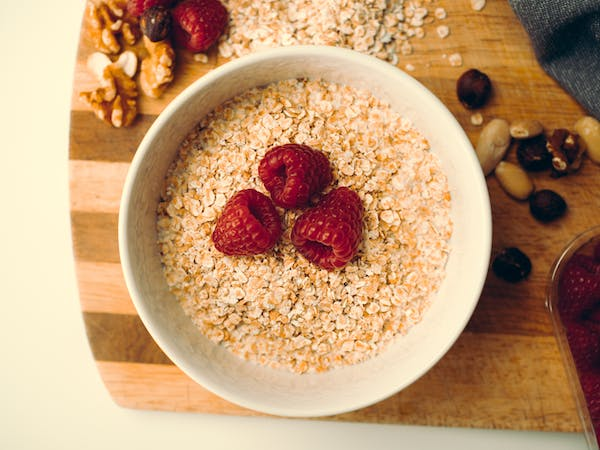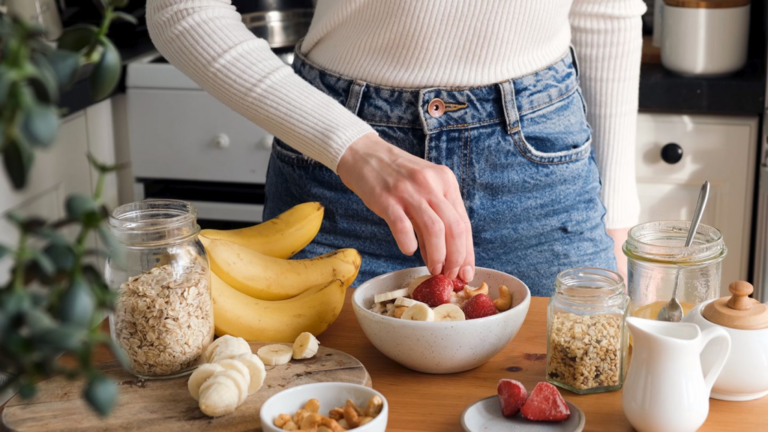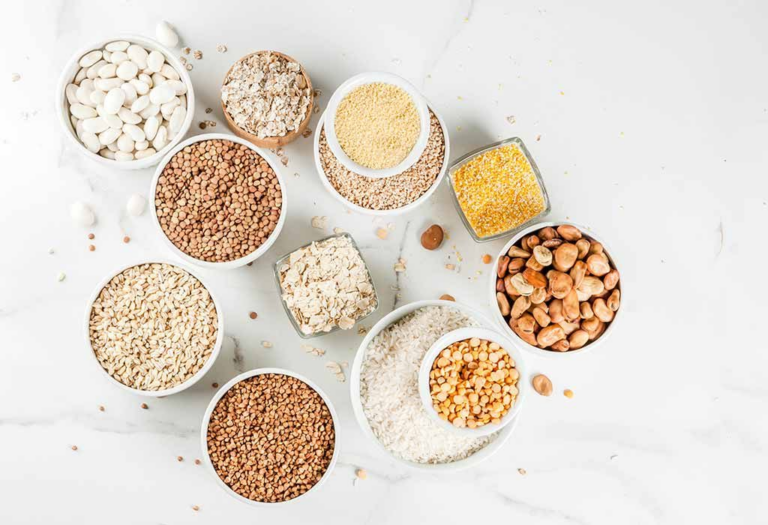NUTRITION INFORMATION ON OATMEAL AND ITS WELL-BEING ADVANTAGES
Given the growing vogue for low-carb diets, you might be wondering if whole-grain breakfasts like oatmeal still make sense. Whole grains consist of the bran, endosperm, and germ, which are three separate sections that are totally intact. Hence, compared to processed or refined grains, whole grains have more nutrients, vitamins, minerals, and fiber.
Particularly oats are rich in beta-glucan, a type of soluble fiber that is good for heart health. The majority of specialists concur that oatmeal has a very valid place in a healthy diet.
OATMEAL NUTRITION FACTS
The following nutrition information is provided by the USDA for 1/2 cup dry (39g) rolled oats with no sugar or salt added.1 This serving is equivalent to 1 cup of cooked oatmeal (cooked in water).
- Calories: 140
- Fat: 2.5g
- Sodium: 0mg
- Carbohydrates: 28g
- Fiber: 4g
- Sugars: 0g
- Protein: 5g
Carbs
Oats provide almost 30 grams of complex carbohydrates in one cup cooked. With 4 grams of fiber and no added sugar, oats are a healthier choice than many processed breakfast cereals.2
The glycemic index of rolled oats is estimated to be about 57, and the glycemic load is 11. Oatmeal is considered to be a moderately low glycemic food. The larger the particle size of oatmeal, the lower its glycemic value. For instance, oats ground into flour produce a higher glycemic response than those in a flake form.3
Fats
Plain oats have minimal fat with 2.5 grams per serving. The fats in oatmeal are mostly polyunsaturated and monounsaturated fats with very little saturated fat.1
Protein
Oats are a good source of protein, providing about 5 grams per serving. As with most plant foods, oatmeal does not offer the full range of essential amino acids required by the body. Nonetheless, oatmeal helps contribute to your daily protein requirements.
Vitamins and Minerals
Oats are a good source of manganese, a component of antioxidant enzymes, important in facilitating bone development and helping to make and break down glucose.4 Oats are also a good source of iron, magnesium, zinc, and selenium.
Calories
The calories in oatmeal come mostly from the carbohydrates it contains. Carbohydrates provide roughly 100 calories, while fat and protein each provide roughly 20 calories each. Half a cup of oatmeal provides about 140 total calories.
HEALTH BENEFITS
Oatmeal is a useful health food that provides both internal and external health benefits.
Aids Weight Loss
Nutrition experts suggest replacing refined grains, like white bread, pasta, bagels, or other breakfast pastries with whole-grain foods to promote satiety and healthy weight management.5 Plain oatmeal is a great alternative to less nutritious grain-based breakfast foods (like muffins and cereal made with refined grains). Oatmeal cups are a great on-the-go breakfast idea for those looking for a nutritious start while heading out the door.
Soothes Skin
Colloidal oatmeal, made by boiling ground oats, is an effective way to soothe itchy skin, reduce psoriasis symptoms, and help treat atopic dermatitis.6 Colloidal oatmeal’s anti-inflammatory effects make it a soothing skin moisturizer. Additional skin benefits include U.V. protection and antifungal effects.
Helps Control Type 2 Diabetes
A review of 16 studies shows moderate benefits of oat consumption on type 2 diabetes management.7 A reduction in hemoglobin A1c values (a 3-month indicator of blood sugar levels) has been associated with oat intake, along with improvements in heart-health markers, a common co-morbidity.
Lowers Cholesterol
Oats have more soluble fiber than most grains. Soluble fiber helps lower LDL cholesterol levels, particularly the type of fiber found in oatmeal, beta-glucan.8
Supports a Gluten-Free Diet (Usually)
Oats are naturally gluten-free and well-tolerated by the majority of people with celiac disease. However, oats are susceptible to cross-contamination with gluten-grains. Choosing brands that are specifically gluten-free and who follow a strict purity protocol reduces the risk of cross-contamination.9
ALLERGIES
According to the American Academy of Allergy, Asthma, and Immunology (AAAAI), oat allergy symptoms may include itching to the mouth and throat and increased heart rate, although individual symptoms may vary.10 If you are allergic to oats, you may have to watch out for skincare products containing oatmeal, in addition to food products.
Due to potential cross-contamination among grains during food processing, you may need to avoid oats if you have a known allergy to another grain. Consult a qualified healthcare provider for personalized allergy advice.
ADVERSE EFFECTS
For some people, increasing the intake of fiber from foods like oatmeal can cause uncomfortable gas and bloating.11 Although these symptoms are usually temporary, you can reduce these negative side effects by drinking plenty of water, staying physically active, and gradually adding in more fiber over a period of time rather than all at once.
VARIETIES
Oats can be processed into a variety of oatmeal products. Typically, an increase in processing increases the oats’s glycemic index (how quickly it raises blood sugar).3 Popular oatmeal varieties include:
- Groats: These are the whole kernel with only the husk removed (minimally processed).
- Steel-cut oats: Otherwise known as Irish oats, steel-cut oats are groat oats that are toasted and cut into tiny chunks with a steel blade. When cooked, they develop a chewy texture.
- Rolled oats: Typically marketed as old-fashioned oats, this is what’s typically sold as oatmeal. The groat oats are softened with steam and flattened by metal rollers.
- Quick-cooking oats: Rolled oats that are pressed even thinner than regular rolled oats are called quick-cooking oats.
- Instant oatmeal: Often packaged with added flavors and sugar, instant oatmeal is made of partially-cooked and dried rolled oats.
STORAGE AND FOOD SAFETY
Store dry oats in a tightly closed container in a cool, dry place. Use them by their best buy date, or within a year of opening. Traditional oatmeal (rolled oats) can be consumed raw because bacteria are destroyed in the steam-press during processing.12
Ingham B. The safety of raw oatmeal. Safe & Healthy: Preparing & Preserving Food at Home. University of Wisconsin-Madison. Division of Extension.
When cooking oatmeal over a hot stove or in the microwave, the quality is best when they are consumed right away, but cooked oats can be stored in the refrigerator and reheated. If making overnight oats, oats must be soaked in the refrigerator rather than on the counter-top at room temperature.
HOW TO PREPARE
Adding your own flavor to oatmeal with cinnamon, nuts, vanilla, or even a quick drizzle of maple syrup is generally more nutritious than choosing flavored oatmeal packets. Follow the instructions on the package for proper cooking times based on the type of oatmeal you purchase. Steel-cut oats take longer to cook than quick-cooking oats, for instance.
Oats can be eaten raw, softened in overnight oat recipes, or cooked as hot porridge. Cook in the microwave or on the stovetop in water, milk, or milk alternatives. They are a great addition to homemade protein balls or energy bites—and you can even add in a scoop of greens powder for an added boost of vitamins and minerals. Oats can also replace breadcrumbs or act as a binder in recipes, like meatloaf. Use oats to add fiber and texture to bread and cookies, or make your own low-sugar granola to enjoy as a snack or topping.



